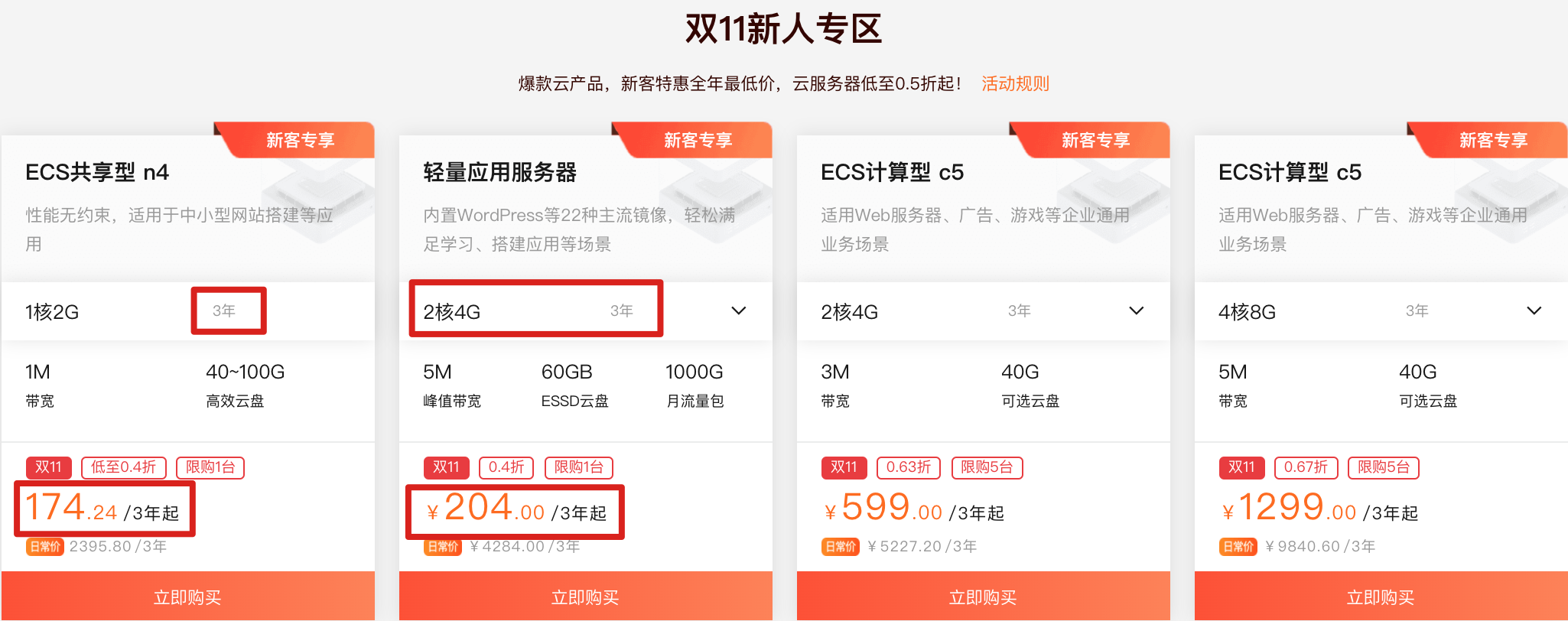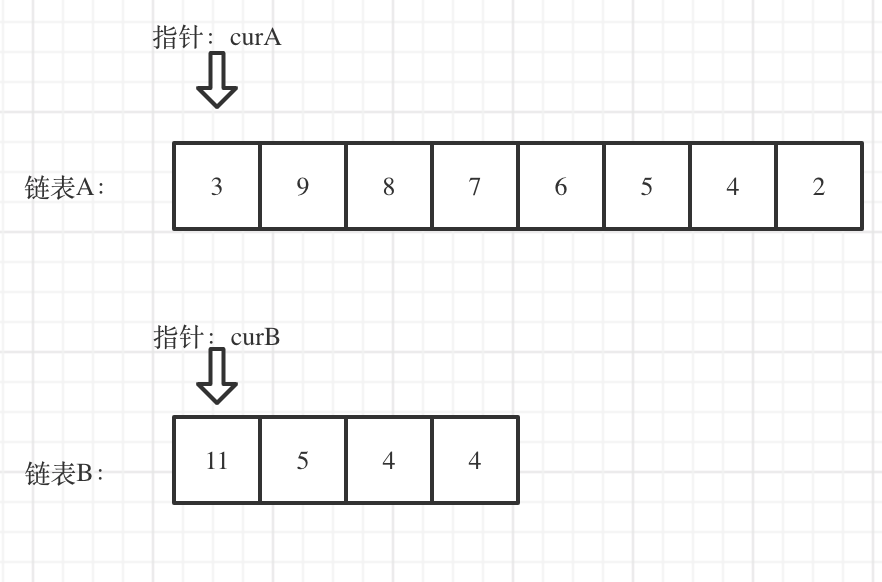给定两个(单向)链表,判定它们是否相交并返回交点。请注意相交的定义基于节点的引用,而不是基于节点的值。换句话说,如果一个链表的第k个节点与另一个链表的第j个节点是同一节点(引用完全相同),则这两个链表相交。
示例 1:
输入:listA = [4,1,8,4,5], listB = [5,0,1,8,4,5]
输出:Reference of the node with value = 8
输入解释:相交节点的值为 8 (注意,如果两个列表相交则不能为 0)。从各自的表头开始算起,链表 A 为 [4,1,8,4,5],链表 B 为 [5,0,1,8,4,5]。在 A 中,相交节点前有 2 个节点;在 B 中,相交节点前有 3 个节点。
本来很简洁明了的一道题,让题目描述搞的云里雾里的。
简单来说,就是求两个链表交点节点的指针。 这里同学们要注意,交点不是数值相等,而是指针相等。
为了方便举例,假设节点元素数值相等,则节点指针相等。
看如下两个链表,目前curA指向链表A的头结点,curB指向链表B的头结点:
我们求出两个链表的长度,并求出两个链表长度的差值,然后让curA移动到,和curB 末尾对齐的位置,如图:
此时我们就可以比较curA和curB是否相同,如果不相同,同时向后移动curA和curB,如果遇到curA == curB,则找到交点。
否则循环退出返回空指针。
C++代码如下:
class Solution {
public:
ListNode *getIntersectionNode(ListNode *headA, ListNode *headB) {
ListNode* curA = headA;
ListNode* curB = headB;
int lenA = 0, lenB = 0;
while (curA != NULL) { // 求链表A的长度
lenA++;
curA = curA->next;
}
while (curB != NULL) { // 求链表B的长度
lenB++;
curB = curB->next;
}
curA = headA;
curB = headB;
// 让curA为最长链表的头,lenA为其长度
if (lenB > lenA) {
swap (lenA, lenB);
swap (curA, curB);
}
// 求长度差
int gap = lenA - lenB;
// 让curA和curB在同一起点上(末尾位置对齐)
while (gap--) {
curA = curA->next;
}
// 遍历curA 和 curB,遇到相同则直接返回
while (curA != NULL) {
if (curA == curB) {
return curA;
}
curA = curA->next;
curB = curB->next;
}
return NULL;
}
};- 时间复杂度:$O(n + m)$
- 空间复杂度:$O(1)$
Java:
/**
* Definition for singly-linked list.
* public class ListNode {
* int val;
* ListNode next;
* ListNode(int x) {
* val = x;
* next = null;
* }
* }
*/
public class Solution {
public ListNode getIntersectionNode(ListNode headA, ListNode headB) {
ListNode curA = headA;
ListNode curB = headB;
int lenA = 0, lenB = 0;
while (curA != null) { // 求链表A的长度
lenA++;
curA = curA.next;
}
while (curB != null) { // 求链表B的长度
lenB++;
curB = curB.next;
}
curA = headA;
curB = headB;
// 让curA为最长链表的头,lenA为其长度
if (lenB > lenA) {
//1. swap (lenA, lenB);
int tmpLen = lenA;
lenA = lenB;
lenB = tmpLen;
//2. swap (curA, curB);
ListNode tmpNode = curA;
curA = curB;
curB = tmpNode;
}
// 求长度差
int gap = lenA - lenB;
// 让curA和curB在同一起点上(末尾位置对齐)
while (gap-- > 0) {
curA = curA.next;
}
// 遍历curA 和 curB,遇到相同则直接返回
while (curA != null) {
if (curA == curB) {
return curA;
}
curA = curA.next;
curB = curB.next;
}
return null;
}
}Python:
# Definition for singly-linked list.
# class ListNode:
# def __init__(self, x):
# self.val = x
# self.next = None
class Solution:
def getIntersectionNode(self, headA: ListNode, headB: ListNode) -> ListNode:
"""
根据快慢法则,走的快的一定会追上走得慢的。
在这道题里,有的链表短,他走完了就去走另一条链表,我们可以理解为走的快的指针。
那么,只要其中一个链表走完了,就去走另一条链表的路。如果有交点,他们最终一定会在同一个
位置相遇
"""
cur_a, cur_b = headA, headB # 用两个指针代替a和b
while cur_a != cur_b:
cur_a = cur_a.next if cur_a else headB # 如果a走完了,那么就切换到b走
cur_b = cur_b.next if cur_b else headA # 同理,b走完了就切换到a
return cur_aGo:
func getIntersectionNode(headA, headB *ListNode) *ListNode {
curA := headA
curB := headB
lenA, lenB := 0, 0
// 求A,B的长度
for curA != nil {
curA = curA.Next
lenA++
}
for curB != nil {
curB = curB.Next
lenB++
}
var step int
var fast, slow *ListNode
// 请求长度差,并且让更长的链表先走相差的长度
if lenA > lenB {
step = lenA - lenB
fast, slow = headA, headB
} else {
step = lenB - lenA
fast, slow = headB, headA
}
for i:=0; i < step; i++ {
fast = fast.Next
}
// 遍历两个链表遇到相同则跳出遍历
for fast != slow {
fast = fast.Next
slow = slow.Next
}
return fast
}javaScript:
/**
* @param {ListNode} headA
* @param {ListNode} headB
* @return {ListNode}
*/
var getListLen = function(head) {
let len = 0, cur = head;
while(cur) {
len++;
cur = cur.next;
}
return len;
}
var getIntersectionNode = function(headA, headB) {
let curA = headA,curB = headB,
lenA = getListLen(headA),
lenB = getListLen(headB);
if(lenA < lenB) {
[curA, curB] = [curB, curA];
[lenA, lenB] = [lenB, lenA];
}
let i = lenA - lenB;
while(i-- > 0) {
curA = curA.next
}
while(curA && curA !== curB) {
curA = curA.next;
curB = curB.next;
}
return curA;
};


